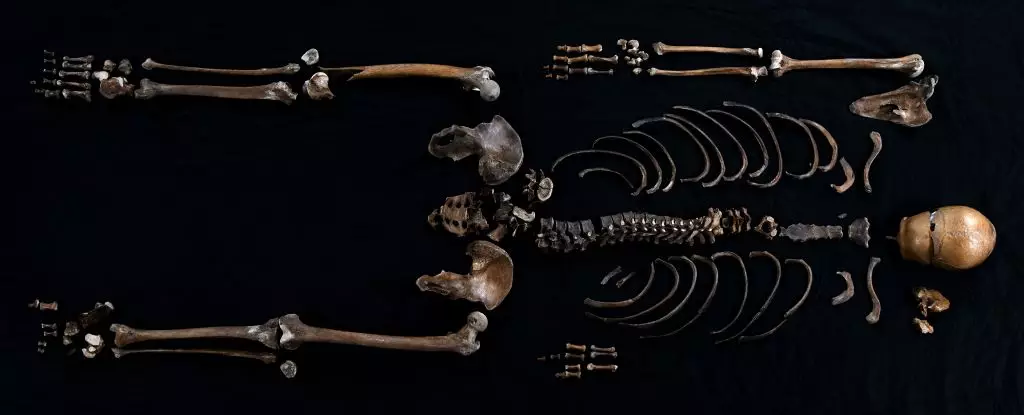The narrative of the Well Man, an 800-year-old incident depicted in the Sverris Saga, has recently moved from the realm of folklore to the vivid reality of archaeological science. This account describes a dramatic moment during King Sverre Sigurdsson’s reign, where an enemy force threw a corpse into a castle well, ostensibly to contaminate the water supply. While this might seem to be a fleeting detail, it has now become pivotal due to the discovery of human remains associated with this narrative, solidifying an extraordinary link between history and tangible evidence.
In 1938, the bones of the Well Man were discovered at Sverresborg Castle near Trondheim, Norway. At that time, the capabilities for analyzing such finds were far more limited than today. Nevertheless, it wasn’t until recently, led by genomicist Martin Ellegaard and his team, that sophisticated scientific techniques such as radiocarbon dating and gene sequencing were applied to unpack the complexities of this individual’s past.
Ellegaard’s research shines a light on the potential to extract information from ancient remains that put a human face to historical accounts. The team established that the bones belonged to a man between 30 and 40 years old when he died, a critical detail which aligns with the timeline of the Sverresborg Castle invasion in 1197 CE. Using radiocarbon dating techniques, the researchers affirmed that the remains dated back approximately 900 years.
In an age where such technologies can differentiate between genetic markers, this analysis revealed more than mere dates; it uncovered physical characteristics of the Well Man—likely having blond or light brown hair, along with blue eyes. Through a vast reference database of contemporary Norwegian genomes, researchers analyzed his genetic lineage and traced his origins to southern Norway, specifically Vest-Agder, indicating that he might have been far removed from the castle during his life.
A remarkable facet of the researchers’ work was the application of isotope analysis. By examining isotopes of carbon and nitrogen from the Well Man’s bones, the scientists could infer dietary habits, suggesting a heavy reliance on seafood. Such knowledge underscores the value of interdisciplinary approaches in archaeology and genetics, as it illustrates the potential lifestyle of historical figures based solely on their biological remains.
While the cause of death remains shrouded in mystery, the saga implies that the earlier estimated siege at the castle led to his demise, though the specific circumstances are not mentioned. This narrative not only raises questions about the fate of the Well Man but also invites scrutiny regarding the broader context of violence during the political turmoil of that era in Norway.
The conflict alluded to in the saga describes a brutal power struggle where Sverre, a focal figure in medieval Norway, faced opposition from a group known as the Baglers. According to the narrative, these adversaries seized the castle in Sverre’s absence and faced little resistance from the unsuspecting townsfolk. However, the description also hints at a potential complexity behind this seemingly straightforward invasion.
Archaeologist Anna Petersén weighs in, noting that the saga’s portrayal may not encapsulate the full reality of the event. The suggestion that there was minimal bloodshed doesn’t account for the presence of the Well Man—who may have been a victim in the skirmish or perhaps even a casualty of the conflict itself. Such nuances reveal that historical texts, while invaluable, can contain inaccuracies, presenting as crafted narratives that paint broad strokes rather than detailed accounts.
Furthermore, the synthesis of genomics and historical texts paves the way for new scholarship that seeks to contextualize personal experiences intertwined within broader events. As genetic research continues to evolve, collaborative efforts demonstrate the dynamic interplay between history, literature, and science, ultimately unraveling the profound mysteries of our past.
The examination of the Well Man not only serves as a testament to the remarkably interconnected landscape of historical events and individual narratives but also exemplifies the radical advancements in scientific methodologies available today. By leveraging these tools, researchers such as Ellegaard and Petersén are unearthing stories of individuals long forgotten, providing depth to our understanding of history. As the saga continues, the legacy of the Well Man endures, transforming a mere line from medieval literature into a captivating Ironic tale of resilience, discovery, and the unyielding quest to understand our collective past.

Leave a Reply